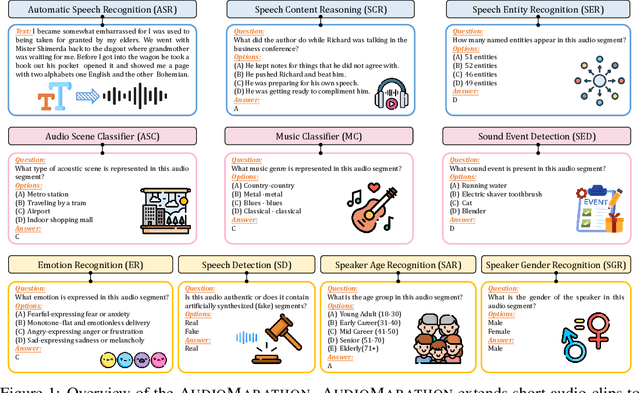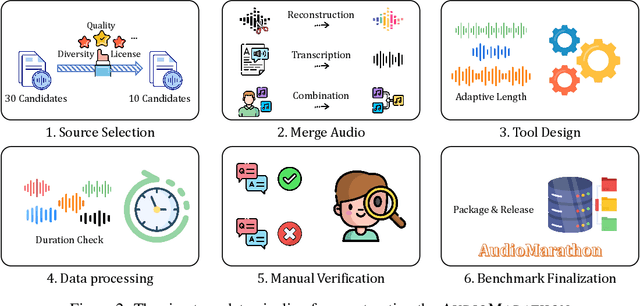speech
Papers and Code
How much speech data is necessary for ASR in African languages? An evaluation of data scaling in Kinyarwanda and Kikuyu
Oct 08, 2025The development of Automatic Speech Recognition (ASR) systems for low-resource African languages remains challenging due to limited transcribed speech data. While recent advances in large multilingual models like OpenAI's Whisper offer promising pathways for low-resource ASR development, critical questions persist regarding practical deployment requirements. This paper addresses two fundamental concerns for practitioners: determining the minimum data volumes needed for viable performance and characterizing the primary failure modes that emerge in production systems. We evaluate Whisper's performance through comprehensive experiments on two Bantu languages: systematic data scaling analysis on Kinyarwanda using training sets from 1 to 1,400 hours, and detailed error characterization on Kikuyu using 270 hours of training data. Our scaling experiments demonstrate that practical ASR performance (WER < 13\%) becomes achievable with as little as 50 hours of training data, with substantial improvements continuing through 200 hours (WER < 10\%). Complementing these volume-focused findings, our error analysis reveals that data quality issues, particularly noisy ground truth transcriptions, account for 38.6\% of high-error cases, indicating that careful data curation is as critical as data volume for robust system performance. These results provide actionable benchmarks and deployment guidance for teams developing ASR systems across similar low-resource language contexts. We release accompanying and models see https://github.com/SunbirdAI/kinyarwanda-whisper-eval
SHANKS: Simultaneous Hearing and Thinking for Spoken Language Models
Oct 08, 2025



Current large language models (LLMs) and spoken language models (SLMs) begin thinking and taking actions only after the user has finished their turn. This prevents the model from interacting during the user's turn and can lead to high response latency while it waits to think. Consequently, thinking after receiving the full input is not suitable for speech-to-speech interaction, where real-time, low-latency exchange is important. We address this by noting that humans naturally "think while listening." In this paper, we propose SHANKS, a general inference framework that enables SLMs to generate unspoken chain-of-thought reasoning while listening to the user input. SHANKS streams the input speech in fixed-duration chunks and, as soon as a chunk is received, generates unspoken reasoning based on all previous speech and reasoning, while the user continues speaking. SHANKS uses this unspoken reasoning to decide whether to interrupt the user and to make tool calls to complete the task. We demonstrate that SHANKS enhances real-time user-SLM interaction in two scenarios: (1) when the user is presenting a step-by-step solution to a math problem, SHANKS can listen, reason, and interrupt when the user makes a mistake, achieving 37.1% higher interruption accuracy than a baseline that interrupts without thinking; and (2) in a tool-augmented dialogue, SHANKS can complete 56.9% of the tool calls before the user finishes their turn. Overall, SHANKS moves toward models that keep thinking throughout the conversation, not only after a turn ends. Animated illustrations of Shanks can be found at https://d223302.github.io/SHANKS/
AudioMarathon: A Comprehensive Benchmark for Long-Context Audio Understanding and Efficiency in Audio LLMs
Oct 08, 2025



Processing long-form audio is a major challenge for Large Audio Language models (LALMs). These models struggle with the quadratic cost of attention ($O(N^2)$) and with modeling long-range temporal dependencies. Existing audio benchmarks are built mostly from short clips and do not evaluate models in realistic long context settings. To address this gap, we introduce AudioMarathon, a benchmark designed to evaluate both understanding and inference efficiency on long-form audio. AudioMarathon provides a diverse set of tasks built upon three pillars: long-context audio inputs with durations ranging from 90.0 to 300.0 seconds, which correspond to encoded sequences of 2,250 to 7,500 audio tokens, respectively, full domain coverage across speech, sound, and music, and complex reasoning that requires multi-hop inference. We evaluate state-of-the-art LALMs and observe clear performance drops as audio length grows. We also study acceleration techniques and analyze the trade-offs of token pruning and KV cache eviction. The results show large gaps across current LALMs and highlight the need for better temporal reasoning and memory-efficient architectures. We believe AudioMarathon will drive the audio and multimodal research community to develop more advanced audio understanding models capable of solving complex audio tasks.
Comparison of Speech Tasks in Human Expert and Machine Detection of Parkinson's Disease
Oct 08, 2025The speech of people with Parkinson's Disease (PD) has been shown to hold important clues about the presence and progression of the disease. We investigate the factors based on which humans experts make judgments of the presence of disease in speech samples over five different speech tasks: phonations, sentence repetition, reading, recall, and picture description. We make comparisons by conducting listening tests to determine clinicians accuracy at recognizing signs of PD from audio alone, and we conduct experiments with a machine learning system for detection based on Whisper. Across tasks, Whisper performs on par or better than human experts when only audio is available, especially on challenging but important subgroups of the data: younger patients, mild cases, and female patients. Whisper's ability to recognize acoustic cues in difficult cases complements the multimodal and contextual strengths of human experts.
Towards Responsible Evaluation for Text-to-Speech
Oct 08, 2025



Recent advances in text-to-speech (TTS) technology have enabled systems to produce human-indistinguishable speech, bringing benefits across accessibility, content creation, and human-computer interaction. However, current evaluation practices are increasingly inadequate for capturing the full range of capabilities, limitations, and societal implications. This position paper introduces the concept of Responsible Evaluation and argues that it is essential and urgent for the next phase of TTS development, structured through three progressive levels: (1) ensuring the faithful and accurate reflection of a model's true capabilities, with more robust, discriminative, and comprehensive objective and subjective scoring methodologies; (2) enabling comparability, standardization, and transferability through standardized benchmarks, transparent reporting, and transferable evaluation metrics; and (3) assessing and mitigating ethical risks associated with forgery, misuse, privacy violations, and security vulnerabilities. Through this concept, we critically examine current evaluation practices, identify systemic shortcomings, and propose actionable recommendations. We hope this concept of Responsible Evaluation will foster more trustworthy and reliable TTS technology and guide its development toward ethically sound and societally beneficial applications.
Open ASR Leaderboard: Towards Reproducible and Transparent Multilingual and Long-Form Speech Recognition Evaluation
Oct 08, 2025Despite rapid progress, ASR evaluation remains saturated with short-form English, and efficiency is rarely reported. We present the Open ASR Leaderboard, a fully reproducible benchmark and interactive leaderboard comparing 60+ open-source and proprietary systems across 11 datasets, including dedicated multilingual and long-form tracks. We standardize text normalization and report both word error rate (WER) and inverse real-time factor (RTFx), enabling fair accuracy-efficiency comparisons. For English transcription, Conformer encoders paired with LLM decoders achieve the best average WER but are slower, while CTC and TDT decoders deliver much better RTFx, making them attractive for long-form and offline use. Whisper-derived encoders fine-tuned for English improve accuracy but often trade off multilingual coverage. All code and dataset loaders are open-sourced to support transparent, extensible evaluation.
Enhancing Speech Emotion Recognition via Fine-Tuning Pre-Trained Models and Hyper-Parameter Optimisation
Oct 08, 2025



We propose a workflow for speech emotion recognition (SER) that combines pre-trained representations with automated hyperparameter optimisation (HPO). Using SpeechBrain wav2vec2-base model fine-tuned on IEMOCAP as the encoder, we compare two HPO strategies, Gaussian Process Bayesian Optimisation (GP-BO) and Tree-structured Parzen Estimators (TPE), under an identical four-dimensional search space and 15-trial budget, with balanced class accuracy (BCA) on the German EmoDB corpus as the objective. All experiments run on 8 CPU cores with 32 GB RAM. GP-BO achieves 0.96 BCA in 11 minutes, and TPE (Hyperopt implementation) attains 0.97 in 15 minutes. In contrast, grid search requires 143 trials and 1,680 minutes to exceed 0.9 BCA, and the best AutoSpeech 2020 baseline reports only 0.85 in 30 minutes on GPU. For cross-lingual generalisation, an EmoDB-trained HPO-tuned model improves zero-shot accuracy by 0.25 on CREMA-D and 0.26 on RAVDESS. Results show that efficient HPO with pre-trained encoders delivers competitive SER on commodity CPUs. Source code to this work is available at: https://github.com/youngaryan/speechbrain-emotion-hpo.
TalkCuts: A Large-Scale Dataset for Multi-Shot Human Speech Video Generation
Oct 08, 2025In this work, we present TalkCuts, a large-scale dataset designed to facilitate the study of multi-shot human speech video generation. Unlike existing datasets that focus on single-shot, static viewpoints, TalkCuts offers 164k clips totaling over 500 hours of high-quality human speech videos with diverse camera shots, including close-up, half-body, and full-body views. The dataset includes detailed textual descriptions, 2D keypoints and 3D SMPL-X motion annotations, covering over 10k identities, enabling multimodal learning and evaluation. As a first attempt to showcase the value of the dataset, we present Orator, an LLM-guided multi-modal generation framework as a simple baseline, where the language model functions as a multi-faceted director, orchestrating detailed specifications for camera transitions, speaker gesticulations, and vocal modulation. This architecture enables the synthesis of coherent long-form videos through our integrated multi-modal video generation module. Extensive experiments in both pose-guided and audio-driven settings show that training on TalkCuts significantly enhances the cinematographic coherence and visual appeal of generated multi-shot speech videos. We believe TalkCuts provides a strong foundation for future work in controllable, multi-shot speech video generation and broader multimodal learning.
Making Machines Sound Sarcastic: LLM-Enhanced and Retrieval-Guided Sarcastic Speech Synthesis
Oct 08, 2025Sarcasm is a subtle form of non-literal language that poses significant challenges for speech synthesis due to its reliance on nuanced semantic, contextual, and prosodic cues. While existing speech synthesis research has focused primarily on broad emotional categories, sarcasm remains largely unexplored. In this paper, we propose a Large Language Model (LLM)-enhanced Retrieval-Augmented framework for sarcasm-aware speech synthesis. Our approach combines (1) semantic embeddings from a LoRA-fine-tuned LLaMA 3, which capture pragmatic incongruity and discourse-level cues of sarcasm, and (2) prosodic exemplars retrieved via a Retrieval Augmented Generation (RAG) module, which provide expressive reference patterns of sarcastic delivery. Integrated within a VITS backbone, this dual conditioning enables more natural and contextually appropriate sarcastic speech. Experiments demonstrate that our method outperforms baselines in both objective measures and subjective evaluations, yielding improvements in speech naturalness, sarcastic expressivity, and downstream sarcasm detection.
Evaluating Self-Supervised Speech Models via Text-Based LLMS
Oct 06, 2025Self-Supervised Learning (SSL) has gained traction for its ability to learn rich representations with low labeling costs, applicable across diverse downstream tasks. However, assessing the downstream-task performance remains challenging due to the cost of extra training and evaluation. Existing methods for task-agnostic evaluation also require extra training or hyperparameter tuning. We propose a novel evaluation metric using large language models (LLMs). By inputting discrete token sequences and minimal domain cues derived from SSL models into LLMs, we obtain the mean log-likelihood; these cues guide in-context learning, rendering the score more reliable without extra training or hyperparameter tuning. Experimental results show a correlation between LLM-based scores and automatic speech recognition task. Additionally, our findings reveal that LLMs not only functions as an SSL evaluation tools but also provides inference-time embeddings that are useful for speaker verification task.
 Add to Chrome
Add to Chrome Add to Firefox
Add to Firefox Add to Edge
Add to Edge